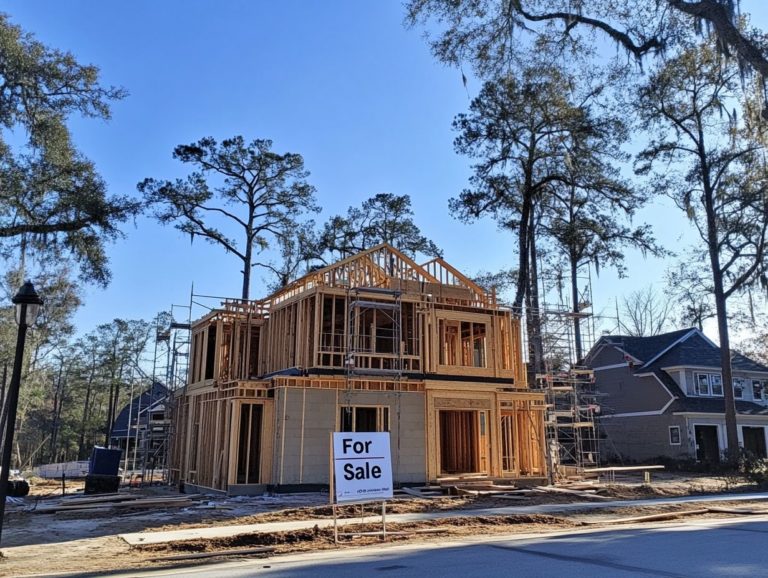How to Understand Home Insurance Providers’ Terminology
Navigating home insurance can be daunting, especially with the variety of jargon and options available.
This guide breaks down essential terminology, explores various types of coverage, and clarifies the factors that influence your premiums.
Discover valuable tips for choosing the right insurance provider and avoiding common pitfalls. By the end, you ll be empowered to understand your home insurance policy better and make informed decisions that protect both your home and finances.
Contents
Key Takeaways:
- Understand key terms to grasp your coverage.
- Know different coverage levels to choose the right policy.
- Compare providers by reviewing coverage, rates, and customer feedback.

Understanding Home Insurance Terminology
Understanding home insurance terminology is vital for homeowners seeking comprehensive financial protection. To navigate the complexities of insurance policies, it’s important to grasp key concepts like liability insurance, premium costs, and the role of home insurance providers.
Knowing these terms will help you navigate the claims process and empower you to make informed decisions about your home insurance policy coverage.
Key Terms and Definitions
Key terms and definitions in homeowners insurance illuminate your rights and responsibilities as a policyholder. This includes crucial elements like liability insurance and various coverage options, which can be better understood by learning how to understand your home insurance policy.
Understanding these concepts is especially important during the intricate claims process, where the insurance adjuster evaluates damages and determines your payout. Knowing about policy exclusions is critical, as these are specific situations or events that might not be covered by your policy, significantly affecting your financial protection.
By familiarizing yourself with terms like premiums, deductibles, and coverage specifics, you empower yourself to make informed decisions. Additionally, understanding the claims process with home insurance providers ensures adequate protection and gives you peace of mind as you safeguard your most valuable asset.
Types of Home Insurance Coverage
Explore a range of home insurance options tailored just for you:
- Standard homeowners insurance
- Dwelling policies for rental properties
- Specialized condominium coverage addressing unique risks associated with condo living
Each option is designed to protect you, regardless of your housing situation.
Explaining Different Levels of Coverage
Understanding the different levels of coverage in homeowners insurance requires grasping the distinctions between actual cash value, replacement value, and additional living expenses. For a deeper dive, consider understanding the limits of home insurance types, especially during catastrophic events.
Each coverage type influences not only your policy cost but also the benefits you can expect during claims. Actual cash value typically means the cost to replace an item minus depreciation, which may result in a lower payout when disaster strikes.
In contrast, replacement value fully covers the cost of replacing damaged items without considering depreciation, providing a more robust safety net.
Policies that include additional living expenses ensure that if your home becomes uninhabitable due to disasters like floods or fires, you maintain financial stability while seeking temporary housing. Understanding these nuances allows you to confidently choose the right combination of coverage to protect your investment effectively.
Factors That Affect Home Insurance Rates

Several factors significantly influence your home insurance rates. These include the market value of your property, its location, your claims history as a homeowner, and the comprehensive risk management strategies that insurance companies utilize to evaluate potential property damage and liability risks.
Understanding these elements can give you the power to make informed decisions about your coverage.
What Determines Your Premium?
Determining your homeowners insurance premium involves a detailed evaluation process that assesses various risk factors. This includes evaluating the value of your personal property, the specifics of your dwelling policy, and the accuracy of your insurance documentation.
This evaluation looks at several risk factors, such as the geographic location of your property, your history of claims, and the materials used in your home’s construction. For example, if your home is in a flood-prone area, you may face higher premiums due to increased risk. Conversely, a solid history of regular maintenance can work in your favor, potentially lowering your costs.
Independent agents significantly influence premiums by helping you navigate your coverage options and negotiating on your behalf. Their expertise can significantly impact how risk is perceived, ultimately affecting the final premium you ll pay.
How to Choose the Right Home Insurance Provider
Selecting the ideal home insurance provider is crucial for securing the right coverage and support you deserve. This process entails a thorough evaluation of various insurance companies, their offerings, and understanding the home insurance claims process that can significantly influence your policy experience.
By taking the time to assess these factors, you can make an informed decision that best meets your needs.
Factors to Consider When Comparing Providers
When evaluating home insurance providers, carefully consider factors such as coverage options, claims evaluation processes, customer reviews, and the company’s reputation for handling insurance fraud to ensure you make the best choice.
Investigate policy exclusions carefully and any endorsements that could enhance your coverage. Understanding what your insurance policy doesn t cover can save you from unexpected surprises when it’s time to file a claim.
It’s crucial to assess the overall reliability of service; noting how swiftly claims are processed and the level of customer support available will offer valuable insights into the company s commitment to its clients.
A thorough comparison of premium rates in relation to the benefits provided can also help you uncover the best value, giving you the power to make informed decisions that cater to your unique needs.
Common Home Insurance Mistakes to Avoid
Don’t let common home insurance mistakes put you at risk! Steering clear of pitfalls like underinsuring your property, neglecting your responsibilities as a policyholder, and becoming a target for insurance fraud is essential.
Tips for Avoiding Costly Mistakes

To protect your home and finances, understanding policy exclusions is not just helpful it’s crucial! Grasping common policy exclusions and taking proactive emergency measures can protect both your property and financial interests.
By familiarizing yourself with the fine print and meticulously documenting any upgrades or repairs made to your home, you can significantly enhance your chances of a successful claim. Make it a habit to review your policy regularly this could save you from unexpected expenses!
Knowing how to file a claim and what documents you need is vital when disaster strikes. Prioritize keeping receipts, photos, and repair records organized in a secure spot, ensuring that future claims are not only simpler but also more straightforward.
Understanding Your Home Insurance Policy
Grasping the intricacies of your home insurance policy is essential for adeptly managing your coverage. By understanding the perils in home insurance types, you gain the power to fully understand critical elements such as insurance documentation, your responsibilities as a policyholder, and the terms stated in your insurance contracts.
This knowledge not only protects you but also enhances your peace of mind, ensuring you are prepared for any situation.
Key Sections to Review and Understand
Review key sections in your homeowners insurance policy. These include coverage limits, policy exclusions, and endorsements, which significantly influence your protection.
Coverage limits define the maximum amount your insurer will pay for a covered loss, providing you peace of mind during unforeseen events. Policy exclusions outline specific circumstances that are not covered, highlighting the importance of knowing exactly what is and isn t included in your policy.
Endorsements let you customize your coverage by adding extra protection for specific items or situations, ensuring that your unique needs and assets are well safeguarded. By grasping these elements, you empower yourself to make informed decisions, ultimately leading to enhanced financial security.
Preguntas Frecuentes
Cu l es la diferencia entre prima y deducible?
La prima se refiere a la cantidad que pagas al proveedor de seguros de manera regular, t picamente mensual o anualmente, para mantener tu p liza. El deducible, por otro lado, es la cantidad que debes pagar de tu bolsillo antes de que entre en vigor la cobertura de tu seguro. Una prima m s alta generalmente significa un deducible m s bajo, y viceversa.
Qu es el l mite de cobertura?

El l mite de cobertura es la cantidad m xima que tu proveedor de seguros pagar por un reclamo cubierto. Es importante revisar cuidadosamente el l mite de cobertura de tu p liza para asegurarte de que satisface tus necesidades y protege adecuadamente tus activos.
Qu es la depreciaci n?
La depreciaci n es la disminuci n en el valor de un activo con el tiempo. En t rminos de seguro de hogar, se refiere a la disminuci n en el valor de tus propiedades personales o la estructura de tu hogar debido a la edad, desgaste o otros factores. En caso de una p rdida cubierta, tu proveedor de seguros tendr en cuenta el valor depreciado al determinar tu pago.
Qu es un anexo?
Un anexo, tambi n conocido como endoso, es un complemento a tu p liza de seguros que proporciona cobertura adicional para art culos o eventos espec ficos. Esto podr a incluir cobertura para art culos de alto valor, desastres naturales u otras circunstancias nicas que no se cubren t picamente en una p liza est ndar.
Qu es el valor en efectivo real?
El valor en efectivo real es la cantidad que tu proveedor de seguros pagar por un reclamo cubierto, teniendo en cuenta el valor depreciado del art culo o propiedad. T picamente es el costo de reemplazo menos la depreciaci n.
Qu es una evaluaci n de p rdidas?
Una evaluaci n de p rdidas es una tarifa que puede cobrar una asociaci n de propietarios o una asociaci n de condominios por reparaciones o da os a reas comunes. Algunas p lizas de seguro pueden proporcionar cobertura para evaluaciones de p rdidas, pero es importante revisar tu p liza para determinar si este es el caso.
Toma el control hoy! Revisa tu p liza y aseg rate de que est s completamente protegido.






